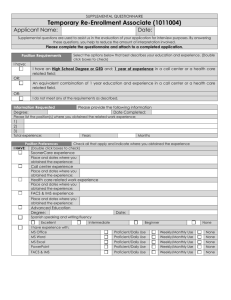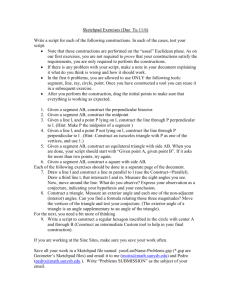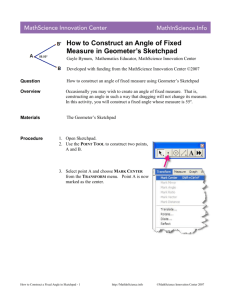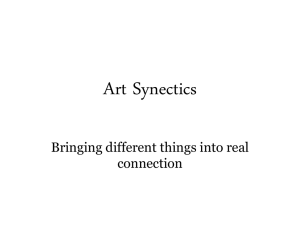Module 3: Geometric Constructions and Trasformations
advertisement
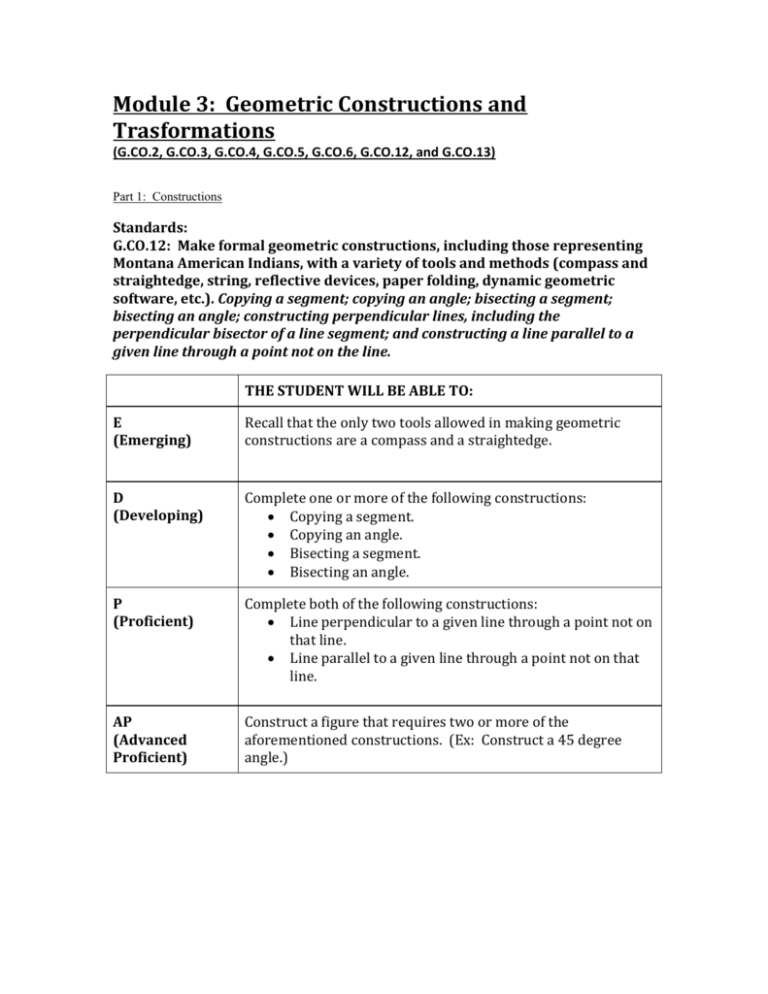
Module 3: Geometric Constructions and Trasformations (G.CO.2, G.CO.3, G.CO.4, G.CO.5, G.CO.6, G.CO.12, and G.CO.13) Part 1: Constructions Standards: G.CO.12: Make formal geometric constructions, including those representing Montana American Indians, with a variety of tools and methods (compass and straightedge, string, reflective devices, paper folding, dynamic geometric software, etc.). Copying a segment; copying an angle; bisecting a segment; bisecting an angle; constructing perpendicular lines, including the perpendicular bisector of a line segment; and constructing a line parallel to a given line through a point not on the line. THE STUDENT WILL BE ABLE TO: E (Emerging) Recall that the only two tools allowed in making geometric constructions are a compass and a straightedge. D (Developing) Complete one or more of the following constructions: Copying a segment. Copying an angle. Bisecting a segment. Bisecting an angle. P (Proficient) Complete both of the following constructions: Line perpendicular to a given line through a point not on that line. Line parallel to a given line through a point not on that line. AP (Advanced Proficient) Construct a figure that requires two or more of the aforementioned constructions. (Ex: Construct a 45 degree angle.) Standard: G.CO.13: Construct an equilateral triangle, a square, and a regular hexagon inscribed in a circle. THE STUDENT WILL BE ABLE TO: E (Emerging) Know that a regular figure is one with equal side lengths and equal interior angle measures. D (Developing) Construct a regular hexagon inscribed in a given circle. P (Proficient) Construct an equilateral triangle inscribed in a given circle. Construct a square inscribed in a given circle. AP (Advanced Proficient) Complete more complicated constructions. (Ex: A circle through three random points, the center of a given circle, or an octagon inscribed in a circle. Part 2: Transformations Standards: G.CO.4: Develop definitions of rotations, reflections, and translations in terms of angles, circles, perpendicular lines, parallel lines, and line segments. G.CO.2: Represent transformations in the plane using, e.g., transparencies and geometry software; describe transformations as functions that take points in the plane as inputs and give other points as outputs. Compare transformations that preserve distance and angle to those that do not (e.g., translation versus horizontal stretch). THE STUDENT WILL BE ABLE TO: E (Emerging) Identify different kinds of translations including translation, rotation, reflection, and vertical and horizontal stretches. D (Developing) Define rotations, reflections, and translations, categorizing a given transformation as either rigid or non-ridged. P (Proficient) Transform a given figure with a stretch, rotation, translation, or reflection. Compare two transformations according to preservation of distance and angle. AP (Advanced Proficient) Defend whether or not the order of a given set of transformations will affect the final figure (ie: rotate first then translate, vs translate then rotate). Standard: G.CO.5: Given a geometric figure and a rotation, reflection, or translation, draw the transformed figure using, e.g., graph paper, tracing paper, or geometry software. Specify a sequence of transformations that will carry a given figure onto another. THE STUDENT WILL BE ABLE TO: E (Emerging) Either by hand or using computer software (ie: Geogebra or Sketchpad) transform one figure into another using one transformation. D (Developing) Either by hand or using computer software (ie: Geogebra or Sketchpad) transform one figure into another using two transformations. P (Proficient) Either by hand or using computer software (ie: Geogebra or Sketchpad) transform one figure into another using three transformations. Given two figures, describe the transformations that will carry onto the other. AP (Advanced Proficient) Either by hand or using computer software (ie: Geogebra or Sketchpad) transform one figure into another using more than three transformations. Standard: G.CO.3: Given a rectangle, parallelogram, trapezoid, or regular polygon, describe the rotations and reflections that carry it onto itself. THE STUDENT WILL BE ABLE TO: E (Emerging) Recognize that rectangles, parallelograms, trapezoids, and regular polygons can be rotated or reflected onto themselves. D (Developing) Using computer software, experiment with rotations or reflections to transform a given figure onto itself. P (Proficient) Determine mathematically the angle of rotational symmetry of a figure. Describe how an object can be transformed using reflections onto itself. AP (Advanced Proficient) For a given figure, determine which points can be used as a center of rotation that give the same angle of rotational symmetry. Standard: G.CO.6: Use geometric descriptions of rigid motions to transform figures and to predict the effect of a given rigid motion on a given figure; given two figures, use the definition of congruence in terms of rigid motions to decide if they are congruent. THE STUDENT WILL BE ABLE TO: E (Emerging) Define rigid motions. D Given a figure and a rigid motion, draw the resulting figure. (Developing) P (Proficient) Given two figures, determine whether or not they are congruent using rigid motions. AP (Advanced) Create a proof that two figures are congruent using rigid motions.


